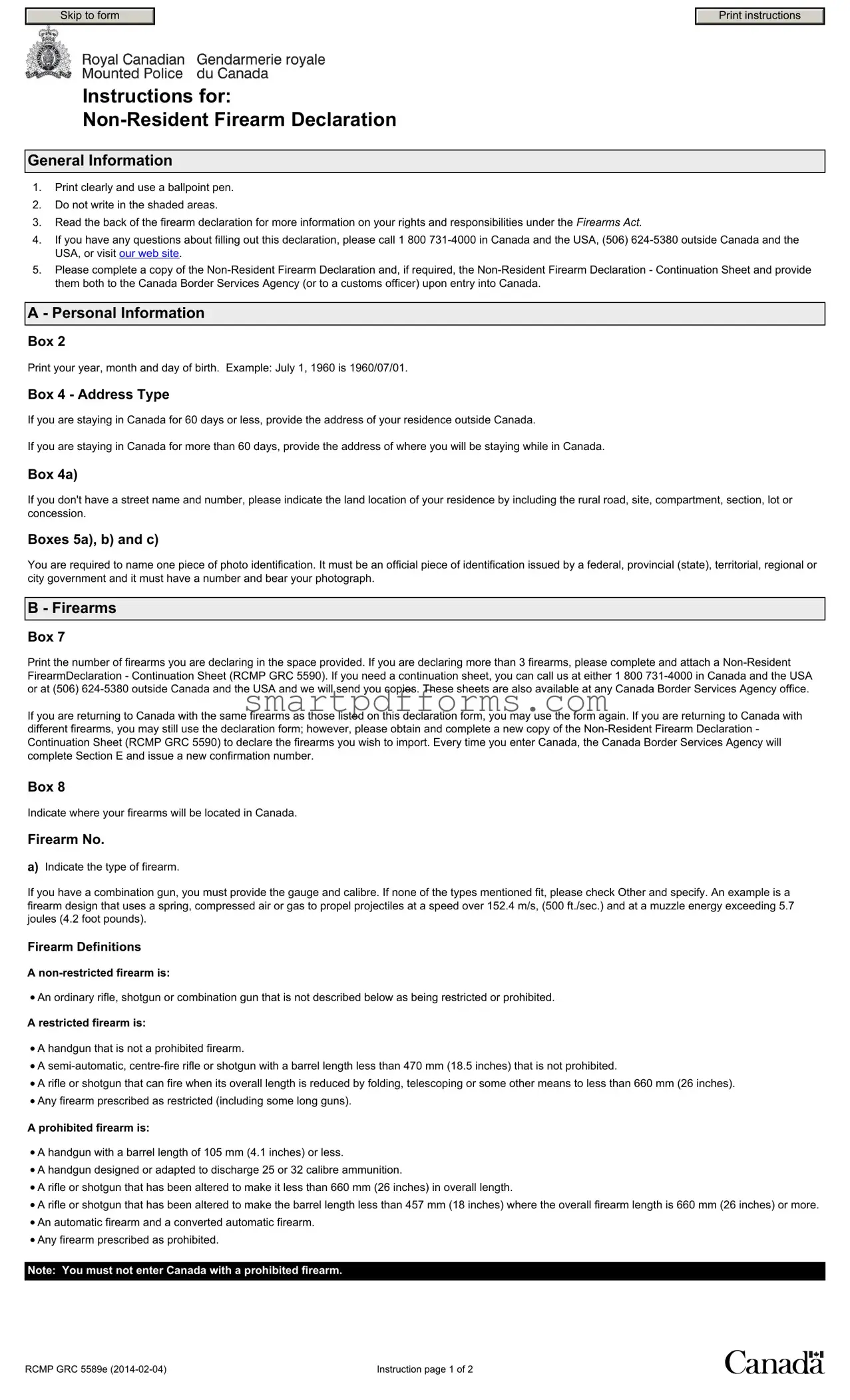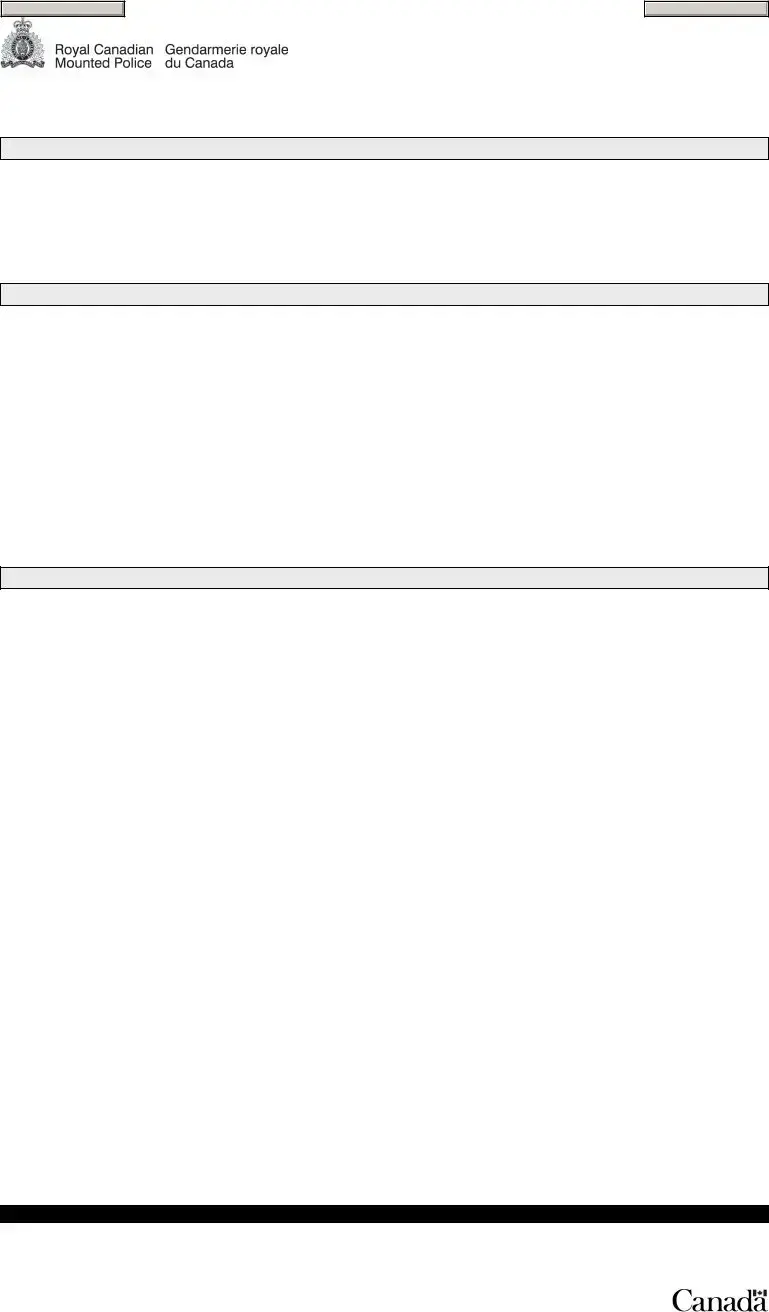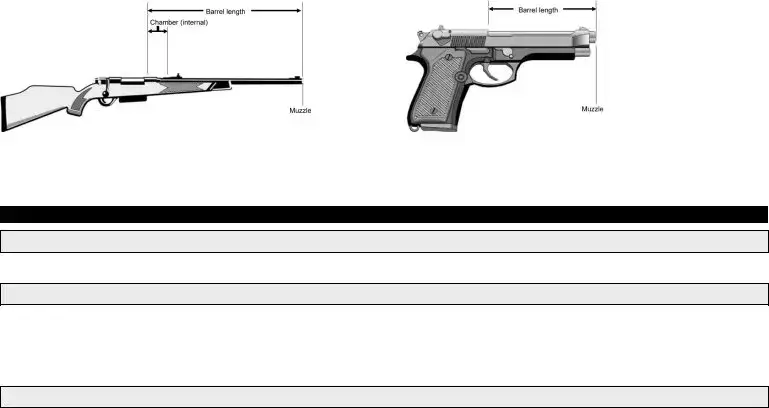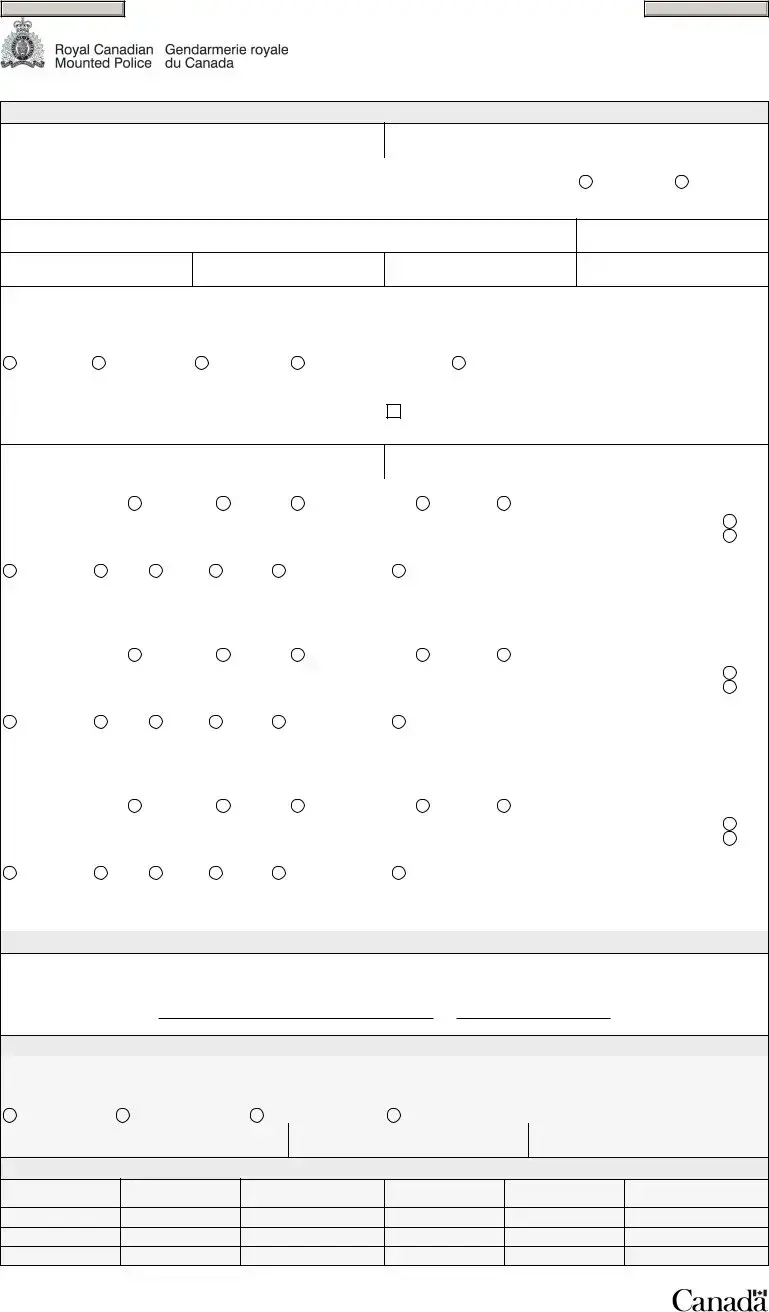Instructions for:
Non-Resident Firearm Declaration
General Information
1.Print clearly and use a ballpoint pen.
2.Do not write in the shaded areas.
3.Read the back of the firearm declaration for more information on your rights and responsibilities under the Firearms Act.
4.If you have any questions about filling out this declaration, please call 1 800 731-4000 in Canada and the USA, (506) 624-5380 outside Canada and the USA, or visit our web site.
5.Please complete a copy of the Non-Resident Firearm Declaration and, if required, the Non-Resident Firearm Declaration - Continuation Sheet and provide them both to the Canada Border Services Agency (or to a customs officer) upon entry into Canada.
A - Personal Information
Box 2
Print your year, month and day of birth. Example: July 1, 1960 is 1960/07/01.
Box 4 - Address Type
If you are staying in Canada for 60 days or less, provide the address of your residence outside Canada.
If you are staying in Canada for more than 60 days, provide the address of where you will be staying while in Canada.
Box 4a)
If you don't have a street name and number, please indicate the land location of your residence by including the rural road, site, compartment, section, lot or concession.
Boxes 5a), b) and c)
You are required to name one piece of photo identification. It must be an official piece of identification issued by a federal, provincial (state), territorial, regional or city government and it must have a number and bear your photograph.
B - Firearms
Box 7
Print the number of firearms you are declaring in the space provided. If you are declaring more than 3 firearms, please complete and attach a Non-Resident FirearmDeclaration - Continuation Sheet (RCMP GRC 5590). If you need a continuation sheet, you can call us at either 1 800 731-4000 in Canada and the USA or at (506) 624-5380 outside Canada and the USA and we will send you copies. These sheets are also available at any Canada Border Services Agency office.
If you are returning to Canada with the same firearms as those listed on this declaration form, you may use the form again. If you are returning to Canada with different firearms, you may still use the declaration form; however, please obtain and complete a new copy of the Non-Resident Firearm Declaration - Continuation Sheet (RCMP GRC 5590) to declare the firearms you wish to import. Every time you enter Canada, the Canada Border Services Agency will complete Section E and issue a new confirmation number.
Box 8
Indicate where your firearms will be located in Canada.
Firearm No.
a)Indicate the type of firearm.
If you have a combination gun, you must provide the gauge and calibre. If none of the types mentioned fit, please check Other and specify. An example is a firearm design that uses a spring, compressed air or gas to propel projectiles at a speed over 152.4 m/s, (500 ft./sec.) and at a muzzle energy exceeding 5.7 joules (4.2 foot pounds).
Firearm Definitions
A non-restricted firearm is:
 An ordinary rifle, shotgun or combination gun that is not described below as being restricted or prohibited.
An ordinary rifle, shotgun or combination gun that is not described below as being restricted or prohibited.
A restricted firearm is:
 A handgun that is not a prohibited firearm.
A handgun that is not a prohibited firearm.
 A semi-automatic, centre-fire rifle or shotgun with a barrel length less than 470 mm (18.5 inches) that is not prohibited.
A semi-automatic, centre-fire rifle or shotgun with a barrel length less than 470 mm (18.5 inches) that is not prohibited.
 A rifle or shotgun that can fire when its overall length is reduced by folding, telescoping or some other means to less than 660 mm (26 inches).
A rifle or shotgun that can fire when its overall length is reduced by folding, telescoping or some other means to less than 660 mm (26 inches).
 Any firearm prescribed as restricted (including some long guns).
Any firearm prescribed as restricted (including some long guns).
A prohibited firearm is:
 A handgun with a barrel length of 105 mm (4.1 inches) or less.
A handgun with a barrel length of 105 mm (4.1 inches) or less.
 A handgun designed or adapted to discharge 25 or 32 calibre ammunition.
A handgun designed or adapted to discharge 25 or 32 calibre ammunition.
 A rifle or shotgun that has been altered to make it less than 660 mm (26 inches) in overall length.
A rifle or shotgun that has been altered to make it less than 660 mm (26 inches) in overall length.
 A rifle or shotgun that has been altered to make the barrel length less than 457 mm (18 inches) where the overall firearm length is 660 mm (26 inches) or more.
A rifle or shotgun that has been altered to make the barrel length less than 457 mm (18 inches) where the overall firearm length is 660 mm (26 inches) or more.
 An automatic firearm and a converted automatic firearm.
An automatic firearm and a converted automatic firearm.
 Any firearm prescribed as prohibited.
Any firearm prescribed as prohibited.
Note: You must not enter Canada with a prohibited firearm.
RCMP GRC 5589e (2014-02-04) |
Instruction page 1 of 2 |


 An ordinary rifle, shotgun or combination gun that is not described below as being restricted or prohibited.
An ordinary rifle, shotgun or combination gun that is not described below as being restricted or prohibited. A handgun that is not a prohibited firearm.
A handgun that is not a prohibited firearm. A
A  A rifle or shotgun that can fire when its overall length is reduced by folding, telescoping or some other means to less than 660 mm (26 inches).
A rifle or shotgun that can fire when its overall length is reduced by folding, telescoping or some other means to less than 660 mm (26 inches). Any firearm prescribed as restricted (including some long guns).
Any firearm prescribed as restricted (including some long guns). A handgun with a barrel length of 105 mm (4.1 inches) or less.
A handgun with a barrel length of 105 mm (4.1 inches) or less. A handgun designed or adapted to discharge 25 or 32 calibre ammunition.
A handgun designed or adapted to discharge 25 or 32 calibre ammunition. A rifle or shotgun that has been altered to make it less than 660 mm (26 inches) in overall length.
A rifle or shotgun that has been altered to make it less than 660 mm (26 inches) in overall length. A rifle or shotgun that has been altered to make the barrel length less than 457 mm (18 inches) where the overall firearm length is 660 mm (26 inches) or more.
A rifle or shotgun that has been altered to make the barrel length less than 457 mm (18 inches) where the overall firearm length is 660 mm (26 inches) or more. An automatic firearm and a converted automatic firearm.
An automatic firearm and a converted automatic firearm. Any firearm prescribed as prohibited.
Any firearm prescribed as prohibited.

